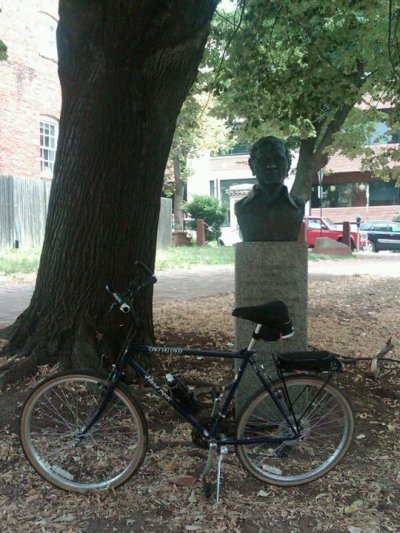Nominated by President Franklin D. Roosevelt, William Orville Douglas was confirmed as an Associate Justice of the U.S. Supreme Court at the age of 40, becoming one of the youngest justices appointed to the court. His subsequent tenure on the court lasted over 36 years, making his the longest term in the history of the Supreme Court. Douglas also holds a number of other records, including for the most decisions, for making more speeches than any other Justice, and for sidebar productivity. Douglas also holds the record among Justices for having had the most wives (four) and the most divorces (three) while on the bench.
However, it was not for his judicial career, but rather his environmental legacy, that a statue of Douglas was erected near the Chesapeake and Ohio (C&O) Canal and Towpath where it intersects with 30th Street (MAP) in the Georgetown neighborhood of northwest D.C. It was this statue that was the destination of this lunchtime bike ride.
Douglas was a self-professed outdoorsman, and wrote prolifically on his love of the outdoors. His love for the environment was so strong that it even carried through to his judicial reasoning. For example, in his dissenting opinion in the 1972 landmark environmental law case entitled Sierra Club verses Morton, Justice Douglas famously argued that “inanimate objects” such as “alpine meadows, rivers, lakes, estuaries, beaches, ridges, groves of trees, swampland, or even air” should have the legal standing to sue in court. In addition to his opinions and dissenting opinions, he also wrote some thirty books.
While serving as a Supreme Court Justice, Douglas also served on the Board of Directors of the Sierra Club from 1960 to 1962. Douglas’ other environmental activities and credentials include hiking the entire 2,000 miles of the Appalachian Trail from Georgia to Maine, helping to launch the nation’s first law review dedicated solely to environmental issues, and swaying his fellow justices on the court to preserve the Red River Gorge in eastern Kentucky when a proposal to build a dam and flood the gorge reached the court. In fact, based on Douglas’ activism in advocating for the preservation and protection of natural areas and resources across the country, he was given the nickname “Wild Bill.”
But perhaps his best known contribution as an environmentalist was his role in helping to save the C&O Canal Towpath, and inspiring its subsequent designation as a National Park. He was at his D.C. home one morning in 1954 when he read a Washington Post editorial backing a plan to build a highway over or along the historic canal. Incensed, Douglas issued a challenge to the Post editorial writers to walk with him the entire length of the canal, and then decide whether it should be preserved. His efforts convinced the editorial board to change its stance, and helped save the canal.
After that, in the 1960s and early 1970s, Douglas and his wife Cathleen “Cathy” Douglas, whom he married when she was 22 and he was 67, would go for hikes along the canal every Sunday morning. Douglas was also known to take solitary walks on the towpath “when he wanted to think deeply about a case” before the court. Today, five million people a year visit the canal, making it the ninth most popular park in the U.S.

